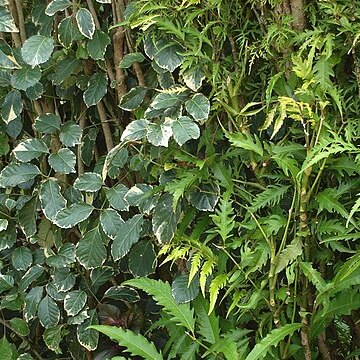Unarmed shrubs or trees, glabrous or furfuraceous. Leaves imparipinnate or 2-3-pinnate (rarely unifoliolate) with an elongated or short sheathing base; rachis articulated; petiole terete; leaflets in pairs, entire, crenate or dentate. Inflorescence terminal, often large, a panicle, corymb, or compound rarely simple umbel. Flowers in umbellules, capitula, or racemose; pedicels articulated below the ovary. Calyx a rim with an undulate or dentate margin. Petals 4-5(-8 or more), valvate. Stamens equal in number to the petals; anthers dorsifixed. Ovary inferior, 4-5(-8 or more)-celled; disk fleshy; styles either free and recurved (at least in fruit) or joined to form a beak-like stylopodium. Fruit a spherical or ovoid drupe, crowned by the persistent calyx rim and the styles or stylopodium; exocarp fleshy, endocarp chartaceous. Endosperm with an uneven surface, fissured, or rarely smooth.
Shrubs or trees, evergreen, hermaphroditic, andromonoecious or dioecious, unarmed, often glabrous, some with sharply aromatic herbage. Leaves 1-5-pinnately compound, margins entire to crenate or serrate; stipules sometimes intrapetiolar and adnate to inside of petiole or absent. Inflorescence a terminal panicle of umbels, heads or spikes, sometimes with a terminal umbel of bisexual flowers and 1 to several lateral umbels of male flowers. Pedicel articulate below ovary. Calyx undulate or with 4 or 5(-8 or more) small lobes. Petals 4 or 5(-8 or more), valvate. Stamens as many as petals. Ovary 4 or 5(-8 or more) carpellate; styles free or rarely connate at base. Fruit a drupe, terete or laterally flattened. Seeds compressed, endosperm smooth.
Aromatic, glabrous shrubs or small trees, often cultivated. Leaf-sheath elongated along the petiole for 1/3-¼ of its length. Styles spreading, at least in the fruit.
Trees or shrubs with imparipinnate leaves. Umbellules arranged in short corymbose compound umbels. Style arms fused, forming a beak-like projection on the fruit.
Trees or shrubs with pinnate or bipinnate leaves. Umbellules arranged in diffuse panicles. Style arms fused, forming a beak-like projection on the fruit.
Inflorescence paniculate, regularly compound, racemosely branched in species of our area, the ultimate divisions of racemules or umbellules.
Trees or shrubs with imparipinnate or bipinnate leaves. Flowers in umbellules or capitula; style arms divergent at least in fruit.
Leaves petiolate, pinnately compound (bipinnate outside our area), glabrous to densely tomentose with stellate (or simple) hairs.
Ovary 2-locular (sometimes 5-locular in other areas); styles 2 (or 5), divergent for nearly all their length.
Tree with bipinnate leaves. Flowers arranged racemosely; style arms free and divergent after anthesis.
Seeds rounded or laterally compressed, ellipsoid, smooth or sometimes ribbed; endosperm non-ruminate.
Leaflets simple (or divided in species outside our area), more or less entire.
Calyx forming a shallow cup, subentire or shallowly 5-toothed.
Trees, often tall and with noticeably regular branching.
Petals and stamens 5; stylopodium not well developed.
Fruit terete (or slightly compressed).

